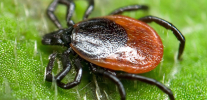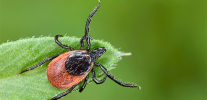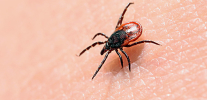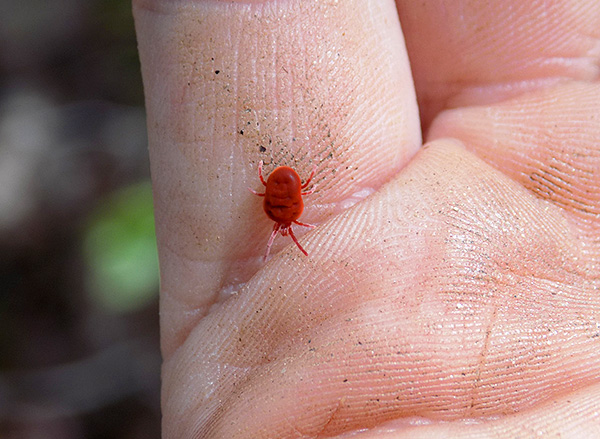
Krasheltelkov mites - family of mites from the order Acariform. This is an extensive group of small arthropods, which got its name because of the bright red covers of the larvae, the color of which increases when they are saturated with blood.
The redbody ticks are characterized by a rather complex development cycle: adults and active nymphs are free-living predators living in the soil and feeding on various invertebrates, while their larvae are typical parasites feeding on the hemolymph of spiders and insects, and sometimes also on vertebrate blood. According to the nature of feeding, the larvae of the red flowers are somewhat similar to ixodic ticks (for example, the taiga tick), and they lack any selectivity for host hosts - the larvae during periods of their activation can massively attack arthropods, mammals, birds,reptiles and amphibians.
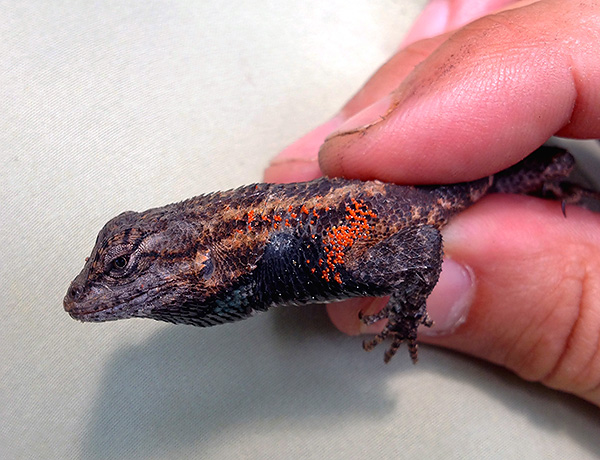

Some species are able to attack humans, feeding on blood and the products of the dissolution of epithelial tissues. The bites of such red-ticks are dangerous and unpleasant, they cause a special form of skin lesions (thrombidiasis). Also, the photostells carry pathogens of a dangerous natural focal disease - tsutsugamushi fever.
On a note
Unlike ixodic ticks, red-shelled mills, fortunately, do not tolerate tick-borne encephalitis and Lyme disease (borreliosis). However, zutsugamushi fever is no less dangerous - in the absence of its treatment, the mortality rate reaches 40%.
About where red-mite mites live, what are the characteristics of their development, nutrition and reproduction, as well as how to protect themselves from their bites, we'll talk further ...
Distribution and habitat
The structure of the super-family Red-mite mites (in Latin Trombea), includes 2 families: Trombidiidae and Trombiculidae, however, representatives of the second family are of much greater practical importance, which will be discussed later. In general, in the world fauna there are about 2,000 species of red beetles, more than 100 of them inhabit the territory of the former USSR.
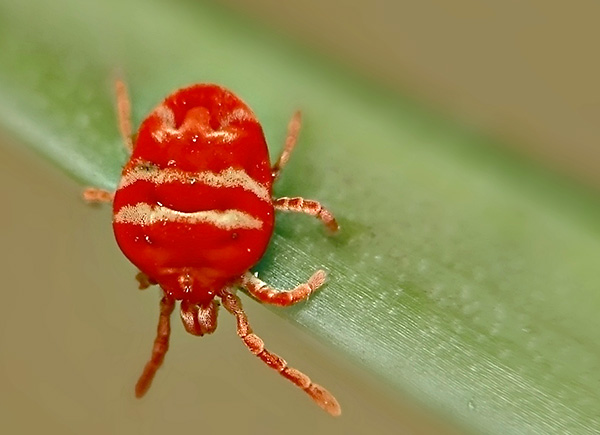
Red fleeder mites are distributed almost all over the world, they are marked on all continents, except Antarctica.These parasites are also found north of the polar circle in the coniferous forests of the Kola Peninsula, however, they were not found in the tundra (this is due to the confinement of individual stages of the red carpet ontogenesis to deep layers of soil that are frozen through in the tundra).
The rich species diversity of Trombikulid is characteristic of the floodplains of large rivers. Some species are found high in the mountains, at an altitude of up to 4000 m.
As for biotopic preferences, red-ticks, like all small arthropods, are very dependent on the microclimatic indicators of a particular area. Moreover, these ticks are characterized by a rigid association with one or another kind of landscape: there are steppe, forest and meadow species that are never found in any other locality.
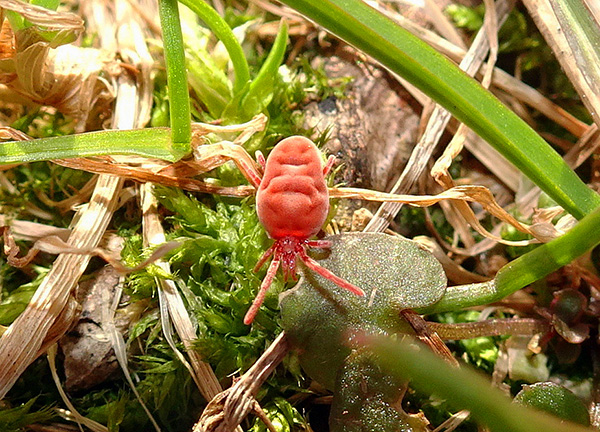
It is interesting
Scientists have conducted studies on the problem of landscape distribution of reddish mites. It was noted that when changing natural conditions, for example, during deforestation, the fauna of the mites in question was completely replaced: over several years, typical forest species were replaced by exclusively steppe ones, and forest redrappers were preserved only in beams.
The question of how exactly this change occurs is not fully understood. Krastotelki are able to migrate only at the larvae stage (on the body of their host), but at the same time the small parasite cannot control in which particular landscape it will stop feeding and fall off. Such migration is random. Adult ticks are earthen, live in the soil, migrate only in the vertical direction, and are not capable of significant movement in the horizontal.
Within the borders of our country redheaters live almost everywhere, but the most widespread species are confined to wet habitats.
Among all the other biotopes, these parasites are most often found in the following places:
- deciduous forests (most species live in the depths of the forest);
- on glades and edges (part still goes to the boundaries of forest plantations, as it is easier to find hosts there);
- shores of sedge-covered lakes;
- river valleys, with forb-grass vegetation;
- pastures and gardens;
- plowed fields (much less).
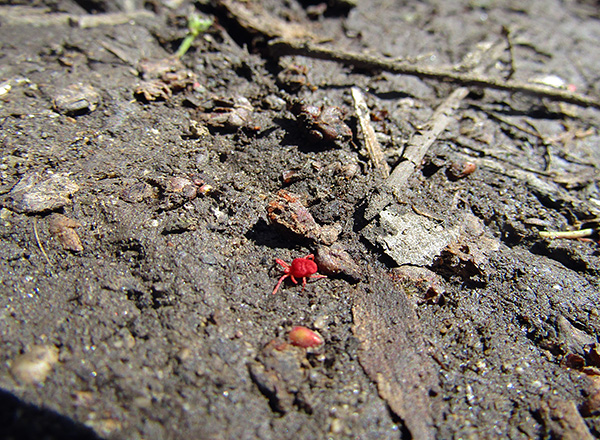
Redies pliers often bite those who decide to rest, for example, in a clearing in the forest. If a person decides to lie down on a succulent grass or leaf litter in places where red flowers congregate, then it is likely to be bitten by their larvae.
Coloring and external structure
Since the larvae of the red flowers are active parasites that represent a certain danger to humans, the description of many species is based precisely on the features of the morphology of the larvae.

On a note
For many types of redies, imago (adult) is not even described, since finding an adult in the soil is not so easy. In addition, given the diverse structure within the same species (polymorphism), it is extremely difficult to compare an adult tillage and a blood-sucking larva, and in some cases it is impossible to compare an adult tillage. In order to make a complete development cycle and describe each stage, scientists need to catch larvae in nature and breed red beetles in the laboratory. This is a difficult and painstaking exercise, which does not always end in success. That is why among the mites redies are considered one of the least studied.
As noted above, the stage of the life cycle of the tick-mite,where it is dangerous to humans - this is the stage of the larva.
The larvae of some species of red flowers are very small, they are not always easy to see with the naked eye: body length of hungry individuals is about 300 microns, and fed - 600-800 microns.

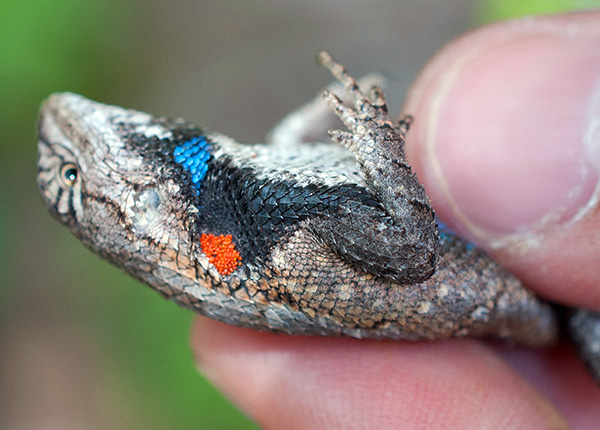
The body of the larva is not segmented, has the form of a bag. In hungry specimens, the integuments are gathered in folds, which, when saturated with a tick, are straightened, thereby increasing the possible amount of absorbed hemolymph or blood.
From above, the red mite is covered with bristles and hairs (trichobothria). Their number and placement on the body is strictly defined and is species specific. The dense arrangement of the bristles and numerous folds on the body of the larvae look like velvet, so the reddisk is also called "red velvet mite" (see photo below):
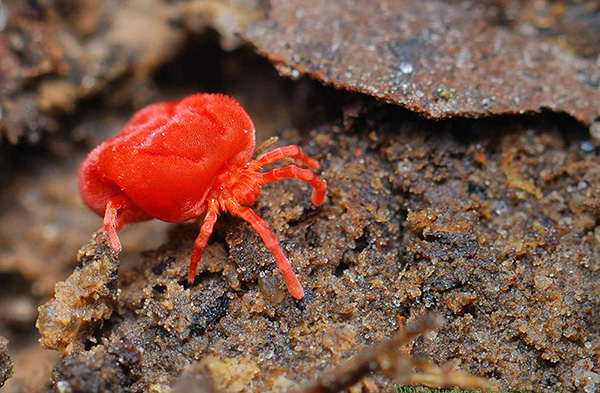
In general, the color of the skin can be very diverse:
- with a bright red back;
- dark red color;
- in addition, the mite can be with a reddish belly and a dot on it.
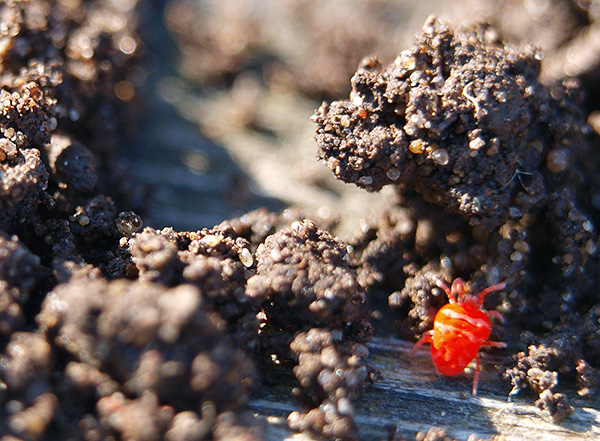
The intensity of the color depends on how much the tick is saturated. The color of the blood that the redling has sucked out is visible through the translucent integuments of the body, therefore the full larva is colored more intensely than its hungry relatives.
On the dorsal side, the tick's body is covered with a scute (dense, wide chitinous formation). It usually has two long setae, sensilla. They perform the function of touch and help the small parasite to find a future victim. It is sensillae and other trichobothria, located on different parts of the body of red-ticks, perform the main sensitive function.
On a note
All the bristles of the redbody mites are located at a certain angle to the body, which allows to reduce the resistance when moving and increase the maneuverability of the parasite. In addition, the mite is flat, and in the aggregate, all these factors contribute to the fact that the reddogs can very quickly move along the surface of the host's body among wool and hair, while firmly clinging to individual hairs if necessary.
At the base of the shield is a pair of primitive eyes - they react only to lighting, and the parasite only senses a change in the light / shadow gradient.
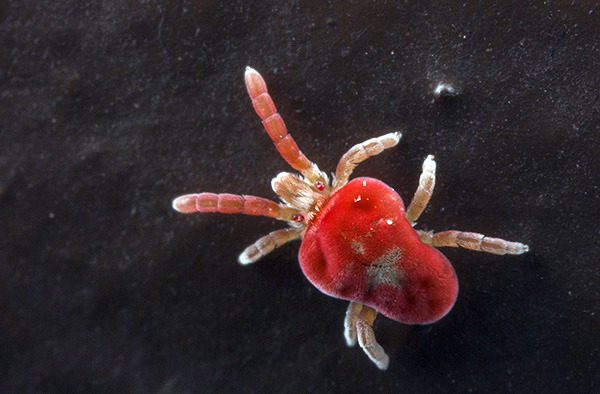
Larvae, unlike nymphs and adults, have not 4, but only 3 pairs of walking legs, so they can be confused with some small reddish bug.
The paws of red ticks are segmented, consist of seven sections and end in sharp claws, with the help of which the parasite clings to the wool or clothing of the future owner.
On the belly is a slit-like anus (excretory pore). Genital opening is absent.
On a note
Coloring beauties does not play a primary role in the identification of these parasites. There are many red insects that look like tick larvae. Moreover, it will not be easy to carry out such an identification to an unprepared person - any small bug with a red booty (belly) may seem visually similar to a redmacker's larva.
Moreover, a number of tick species have a reddish tint, but do not belong to the Trombiculidae family. For example, if you notice a reddish mite on an apple tree that grows on a plot, or on an orchid, a lemon in a room - then, most likely, this is not a red-mite tick, but a spider web. This is a completely different systematic group of parasites: they feed on the sap of plants, and pose absolutely no danger to humans.
Among the beauties there is no separation, for example, on citrus or apple mites, but they may well inhabit the garden on the ground. If you notice a small velvety red tick on a cat, then there is a high probability that it is just a red carpet.
Features of the life cycle
The life cycle of tick-mite consists of seven stages:
- egg;
- predlichinka;
- larva;
- protonymph;
- deutonymph;
- tritonymus;
- adult individual (imago).
Experts note that in the conditions of the south-west of Russia, the red-tick mites have 1-2 generations per year, and individuals of different ages are simultaneously present in the natural environment.
The larva, deutonyphus and imago are active stages, whereas at the stage of prelarvae, proto-and tritonymy typhoids are at rest.

On a note
Initially, it was believed that during the resting stages of the red mite larvae, complex histological processes develop inside, characterized by the dissolution of tissues and organs and the return of the organism to the state of the embryo. However, recent studies have allowed these changes to be associated with a special form of molting, which is a separate phase of individual development. The beginning of the resting stages is now considered immobilization, and the end is the beginning of active movements.
Habitat for all stages of ontogenesis of red-tick mites is soil.Only the larva for a period of feeding leaves it. The female and the male are found in the soil, fertilization - spermatophoric (spermatophore - bag with seminal fluid). The female picks up this sac with genital folds, and fertilization takes place.
After a while, eggs are laid. Eggs are located in the soil cells in groups, in which prelarvae form. Larvae emerge from the prelarvae, which are blood-sucking external parasites, for which selectivity in the choice of host is not characteristic.
The larva feeds on the tissue fluid of insects, spiders, vertebrates and stays on them only during the feeding period. Usually, the larvae accumulate on the soil surface, trapping the host, and actively attack it when approaching.
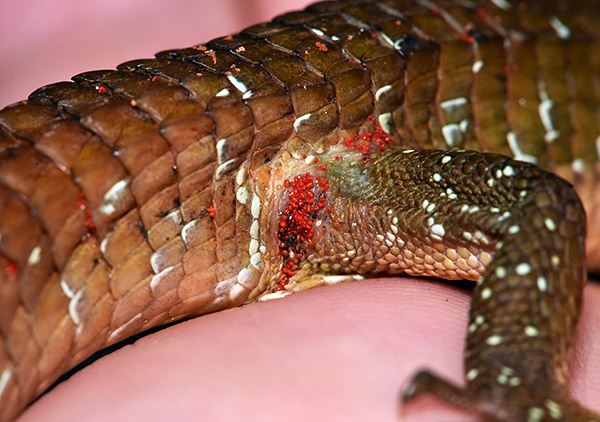
The duration of food on the host depends on the type of tick and can vary from 3-5 to 10-32 days. A well-fed larva leaves the host and re-enters the soil - however, it can be at a considerable distance from the place where it was originally attached.
After the larva enters the soil and consistently passes through all three nymphal stages. Daytonymph and imago are active soil predators that feed on small invertebrates and their eggs (mainly collembleballs).
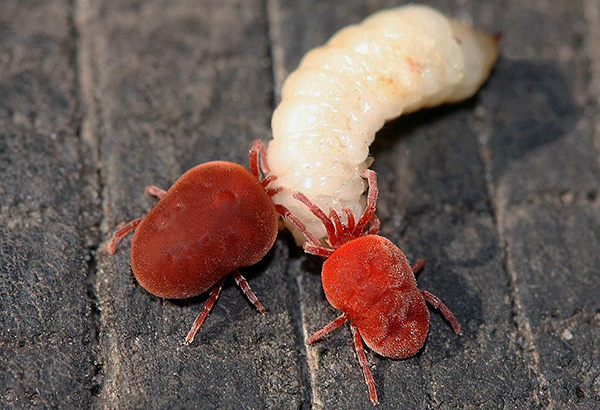
Thus, the relationship between ticks and beasts with their owners is determined, firstly, by their use of the latter as food objects, and secondly, as a means of resettlement. These moments, apparently, determined the peculiarities of parasitism in red-nursed ticks, which we will talk about later.
Nutrition of red ticks
The circle of red-mite ticks is unusually wide. In general, this group is not characterized by any selectivity in the choice of the future host. However, the range of possible hosts narrows depending on the station in which the tick lives.

If it is a steppe species, then, in addition to invertebrates, small mouse-like rodents can be the hosts. In forest red-mite mites, the choice is usually greater, and trophic links also extend to larger mammals.
Studies of the fauna of the Trombiculidae have shown that a large number of red beetle species feed on rodents, less often the saturation occurs on insectivores (urchins and moles). This is followed by the parasitic fauna of bats, birds and reptiles.
People, like primates, appear to be random owners — nevertheless, many little girls can attack a person and suck his blood.
After hatching, the larvae are active, they crawl out of the soil and climb into the upper layers of the leaf litter or on grassy vegetation. During this period, they are characterized by positive phototropism, that is, ticks tend to the light, but at the same time avoid open areas, illuminated by direct sunlight.
After a while, they crawl, forming extensive aggregations, so the bites of red flowers are often massive. In the shelters, the waders expect potential prey.

When a red tick chemoreceptor gets on it, it activates, and the parasite begins to move quickly, actively selecting attachment sites. This process is much faster than, for example, in a black forest tick.
If the owner is a warm-blooded animal, the reddogs choose skin areas with thin covers and a high degree of blood supply, as well as inaccessible for combing and shaking off. In animals, it is mainly:
- nape;
- auricles;
- nose;
- eye area;
- groin area;
- genitals;
- anus and nearanal area.
In some species, the larvae may not look red, but yellowish:
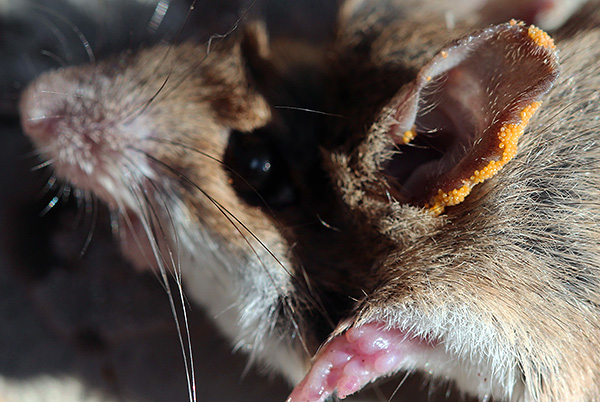

In humans, open places and limbs are the first to be bitten.. The duration of feeding of the larva depends on the species and can last from several hours to two days. After saturation, the larva disappears and begins to actively migrate to the soil, where it passes to the protonymph type. Hungry larvae do not survive the winter and mostly die.
The nature and feeding habits of the red mite are determined by the structure of its oral apparatus, which is called the gnathosome (that is, it is the entire anterior part of the body). A gnatosome consists of 2 pairs of limbs: two-membered chelicera and five-membered pedipalps. At the same time, chelicerae are not enclosed in any protective chambers, which is the main feature of all Acariform ticks.
The head section is clearly separated from the body by a constriction, around which a specific cushion is formed, which performs a number of functions. First, when the tick is attached to the host's body, the roller plays the role of a sucker, thanks to which the parasite is firmly fixed to the victim. Secondly, such a mechanism facilitates the suction of fluid - due to the vacuum action.
On a note
The absorption of hemolymph or blood in the narrow throat of the parasite is carried out mainly due to the contractile movements of the esophagus.When the muscle walls of the pharynx are compressed and relaxed, negative pressure is created and the fluid rises along conductive paths. The skin sucker, in turn, enhances the pressure effect.
Chelicera have the appearance of thin and sharp scalpels. With the outer side of the chelicera, the tick cuts through the integument of the victim, while their inner parts create a chute through which food moves into the digestive tract of the reddisk. Palpy perform a sensitive function due to the bristles located on them. They do not take part in the attachment or feeding of the larvae, so it clings only 6 walking legs.
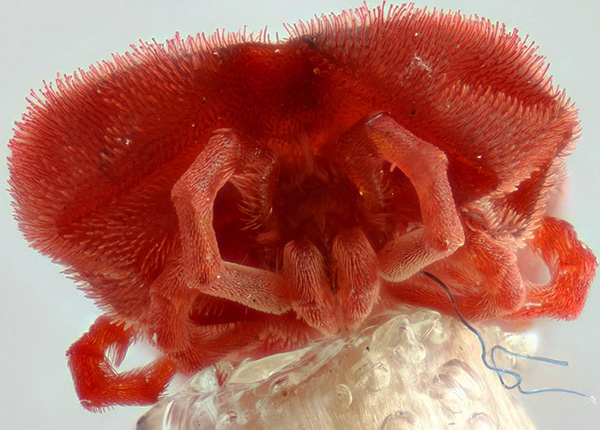
When parasitizing the larvae of the red flowers, a special food tube is formed, called the stylostomy - because of its formation, the host tissues are affected much more than when parasitizing ticks. This is one of the dangers of meeting with red-shelled ticks.
Stilost is a derivative of the activity of the salivary glands and is a thin tube that penetrates deep into the host tissue. Over the course of feeding, the larvae increase in length by the stylostoma, which allows for deep penetration into the integuments with short mouth organs.
On a note
Developed by styling perforates the epidermis through, but never reaches the dermis. At the end of the stylostoma, an accumulation of saliva forms and a focus of inflammation occurs. Blood elements, dead leukocytes and products of lysis of tissues of the upper layers of the skin accumulate in the focus. The longer the tick feeds, the more pronounced the inflammatory reaction becomes. Krasrotelka does not drink only blood - in addition to it, the lysed tissues of the victim constitute the main part of the nutrient substrate, so the bites of redies are more painful than the bites of encephalitic ticks.
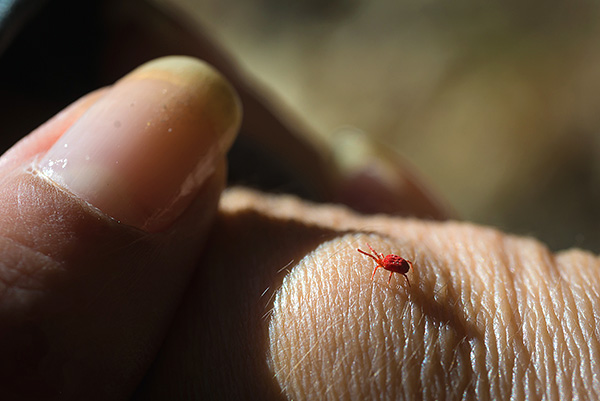
In addition to external parasitism, the larvae of the redis beetle, depending on the species, can live in the respiratory tracts of mammals and birds, as well as move on to subcutaneous parasitism.
Now let's talk about the types of parasitism within the group of beauties, and about what a person should be afraid of in the first place ...
Types of parasitism
As noted above, the larvae of the redfishes are temporary, obligate external parasites, and if they feed on the integuments of small vertebrates, they suck blood and tissue dissolution products. However, this is only one side of the coin: studies have shown that different types of parasitism are characteristic of the larvae of beauties of different species.
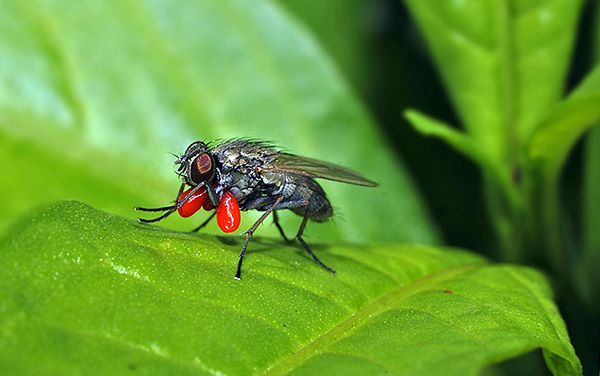
First, it is an external parasitism on the integuments, with a long-term nutrition, as in ixodid ticks. It is in this case that a complete stylosis is formed, and when bitten, a strong inflammatory reaction develops. This type of parasitism is characteristic of most thrombiculides.
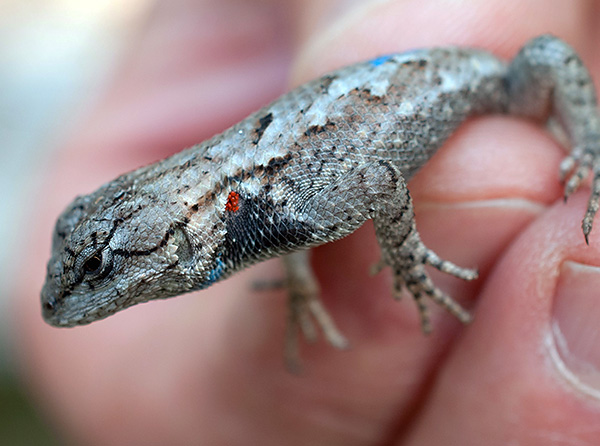
Secondly, it is intracavitary parasitism in the respiratory tract of mammals and birds. At the same time, the mortality of the larvae of red ticks drops significantly due to favorable microclimatic conditions inside the host organism.
Thirdly, for some babies, feeding on amphibians (frogs, toads, salamanders), they are characterized by immersion under the skin of the host.
And finally, fourth, partial immersion in the skin of the host and the formation of a kind of pockets. This type of parasitism is also widespread among the red beetles, and it is characterized by minor inflammation sites, since the depth of the mouth organs and the stylostoma in the integument of the promoter is insignificant.
Such a variety of parasitic adaptations once again indicates a high level of adaptation of red beetles, like parasites, to external factors and the ability to feed on all groups of vertebrates.
Medical value and danger to humans
Every year in our country are recorded cases of bites by beauties of people. When they fall into places of accumulation of these ticks, a person is often immediately subjected to a massive attack. The disease caused by the bites of these parasites is called autumn erythema or thrombidiasis.
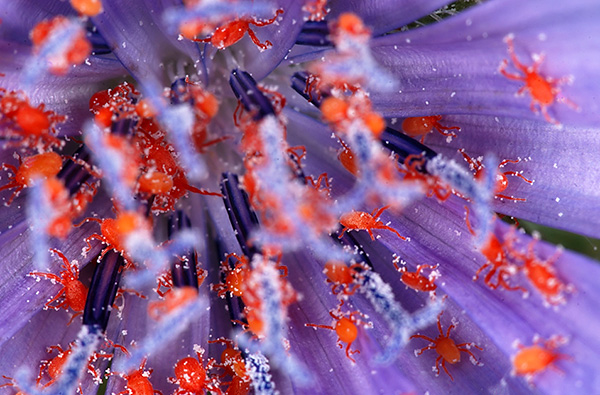
The small size of ticks helps them to remain unnoticed on the body for a long time. They can hide in secluded places: in the hair and in areas with a tight fit of clothing.
At the time of feeding the bloodsucker, the victim does not feel any discomfort, but after a while a red spot forms on the site of the bite (papule, erythema), which itches badly. At night, itching intensifies, and in some places becomes unbearable, and combing leads to increased inflammation, and sometimes to infection in the wound.
Up to 80% of the human body surface can be covered with such erythema. After 5-8 days, redness and inflammation disappear, dark spots remain at the site of bites. When repeated contacts with red-tick-borne mites, a more pronounced allergic reaction often occurs.
If, over time, the patient's condition after bites worsens, then the development of another disease, a natural focal disease called tsutsugamushi, may occur. The causative agent of this dangerous disease is rickettsia, and the natural hosts are various small rodents. It is the ability to tolerate tsutsugamushi fever pathogens that determine the medical significance of reddies.

If the mite has bitten an infected host (for example, a rodent), then the pathogens enter the abdomen of the parasite, after which the saliva is transferred to its saliva, and subsequent bloodsucking causes the disease to be transmitted to a healthy host.
On a note
Tsutsugamushi fever is characterized by rapid clinical development: there is a severe headache, high fever. Patients complain of insomnia, they are irritable and agitated. After a week, a rash appears on the skin, and the face and body slightly swell due to tissue swelling. The fever clinic is very similar to the symptoms of typhus.
The disease lasts about a month, but the main complications are associated with secondary infections.If you do not go to a doctor in time, then the probability of death is 40%.
In countries where zutsugamushi fever (east Asia) is rampant, control measures are routinely carried out in the form of treating natural habitats of red ticks with chemical preparations in order to reduce their numbers. In our country, to fight soil mites with such measures is not accepted.
To protect yourself from the bite of red-ticks, it is necessary to adhere to the basic preventive rules:
- outdoors, wearing closed clothes is recommended - with tight cuffs on hands, lack of openings between pants and socks;
- repellents must be used - soak up protective clothing and wipe the skin;
- it is not recommended to lie on the grass or the ground in places of possible accumulation of red-ticks;
- after being in nature, you must change your clothes and take a shower.
Redies bites are very unpleasant and always carry the threat of infection with pathogens of fever. Only the observance of simple rules and careful attention to your health will allow you to protect yourself from these parasites.
Interesting video: red velvet mite
And so this tick looks at high magnification


